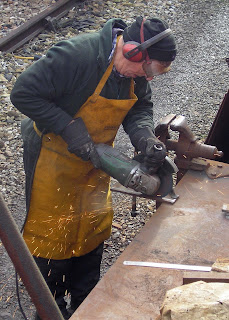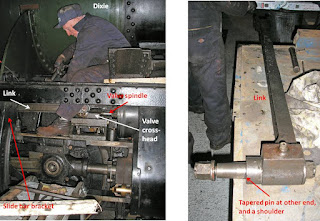Wednesday 27th
Gilbert
made a flat metal template to the same diameter as the new bush, such
that when the pony frame is heated (to expand the hole) we can gauge the
size vis-à-vis the actual bush (without having to risk getting it stuck
in the hole). He also removed the front cover from the LHS piston
valve.
Just
before end-of-play, John helped Bruce lower the loco frames off the
jacks. The frame has to be raised for the reamer to get through the
hole …
…
that Bruce was reaming all day long! Finally, he has reamed it out to
the required size for the new pin to fit. Below this hole is the one in
the pony frame that needs a new bush. To fit the bush we think we
will have to heat the frame to expand it, because it has to be a tight
fit, of course.
I
decided to tackle as many small jobs as I could, because we only have 4
weeks left to get the work done, loco steam tested and ready to run! I
refitted the section of running board to the rear of the LHS valve
(Bruce had noticed two bolts missing from it); fitted the LHS front
cladding on the cylinder; filed a shade off the RHS running board where
the rocking shaft arm had been clobbering it; fitted the vacuum gauge
(but can't fit the pressure gauges until they have been tested);
Bruce
reminded me of a suspected steam leak from the pep pipe (aka slacking
pipe - in the cab), so I inspected the pipe twixt pep valve (in the cab)
and steam feed pipe (from injector to top clack) and discovered that
the pipe had been rubbing against platework beneath the cab. So, the
pipe had to come off. There appears to be a minute split in the pipe,
but Carpo says to hydraulically test it to see how bad it is; it may be
possible to simply silver-solder it up (and then move the pipe away from
the side!).
Saturday 30th
Today was tremendously successful - we really felt we had achieved something. Why? Because the wheels are back on the pony!
There
were two primary activities converging on assembling the pony:
finishing off the underkeeps; and getting the pony frame together.
David and John T spent most of the day completing the straps that hold
the underkeeps up. David had already cut these (4 of) to correct width
with neat edges at home, and now these needed cutting to length and
holes drilling in them for the retaining T-bolts. Inevitably this was
not trivial, as the bolts turned out not to have long enough threads,
and David had to die-cut them to length. The straps have to butt up to
the four tabs on the underkeeps (to prevent the underkeeps from moving
sideways), so getting the holes positioned accurately took time, too.
When
they had completed that work, we could press on with pony assembly;
meanwhile David and John tackled the first of four fitted bolts on the
RHS rocking shaft bracket. The bolt hole was reamed to within 1 thou of
the bolt diameter and the bolt was then persuaded to go home! This
turned out to be challenging, and David recommends not being quite so
tight on the next three!
Bruce
is concerned that the 1/32 inch freedom ("slop") allowed on the pony
pivot pin will only allow the pony wheels to lift by about 1.5 inches,
which is a problem when being loaded onto a lorry! Bruce sought the
opinion of various oracles, but didn't come to any conclusion. Further
investigation is required.
Gil
had ordered oil pads to fit in the underkeeps. These suck up oil by
capillary action and rub it on the axle journals. However, we think the
ones delivered are the wrong sort! Gil & Bruce to sort this out
ASAP.
Alistair
and I began the day by moving the A-frame down to position it above the
pony frame. Then Alistair raised the frame and we swung it round to
give access to the pivot point where the new hardened bush had to be
fitted. We then had to wait until Carpo had time to act as Lucifer. It
took less than 5 minutes for him to heat up the frame; Bruce slipped
the bush into the hole, and with very little persuasion it slid into
place.
Meanwhile,
much shunting was required in order to get the pony wheels from Road 6
onto Road 7. With help from various Loco Dept chaps, chivvied on by
Clive, 4270 and Foremarke's tender were shunted out, and then a few of
us pushed out the wagon (which is under restoration) to free up the
Road. The wheels were shifted across from Road 6 by fork-lift;
deposited on Road 7, and rolled carefully down to the frame. Ray O'H
was hovering around with his camera, so photos of this activity may
appear on the Loco Dept Blog next week (see http://gwsrsteamloco.blogspot.co.uk/).
Alistair
and Mike cleaned and oiled various parts of the axle; boxes and frame.
The final parts of the axle boxes were assembled (i.e. top cover and
rubbers). Eventually, they were ready to fit.
This is a bit of fun,
because if we were to just balance the axlebox on top of the axle, it
would (obviously) swing round and drop off! So they had to have a pile
of wood underneath to prevent them from rotating on the axle. Alistair
again was in charge of the lifting, as the frame took to the air. I was
steering at the sharp end, while Bruce and Mike were manipulating the
wheel end. After much wiggling, jiggling and persuading, the frame did
drop onto the axle. Job done - almost!
Bruce
compared the height of the top of the frame to axle centre with the
drawing, and it appears to be 1.5 inches too high. It has clearly been
too high while in service for the past five years. Nevertheless, we
shall verify this measurement next time, and if appropriate we can lift
the frame again and remove one or two rubbers.
Roger





























